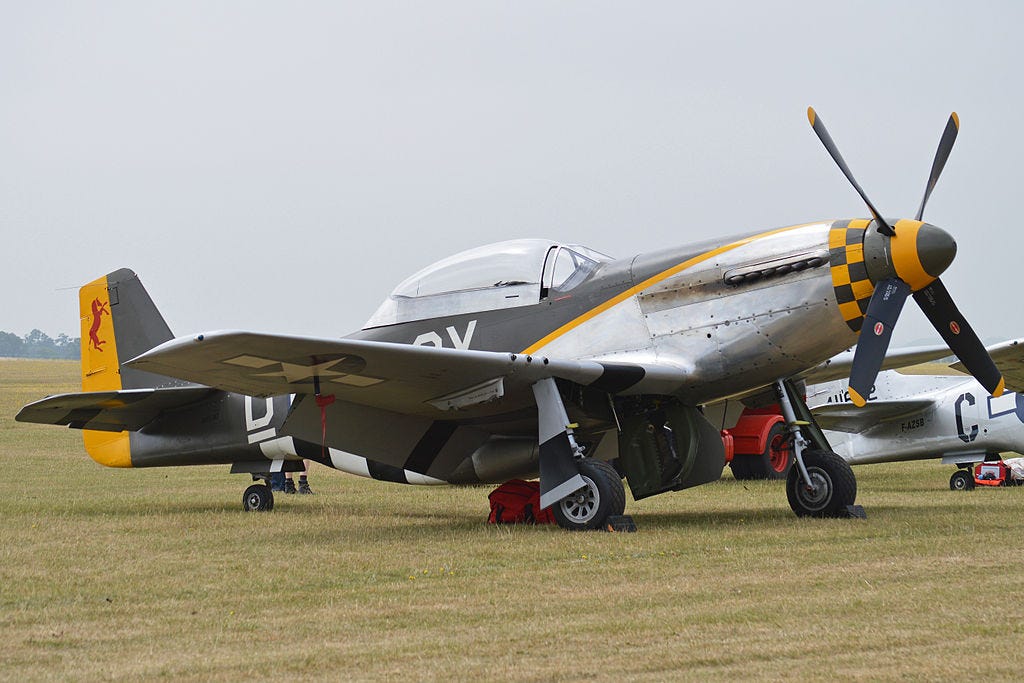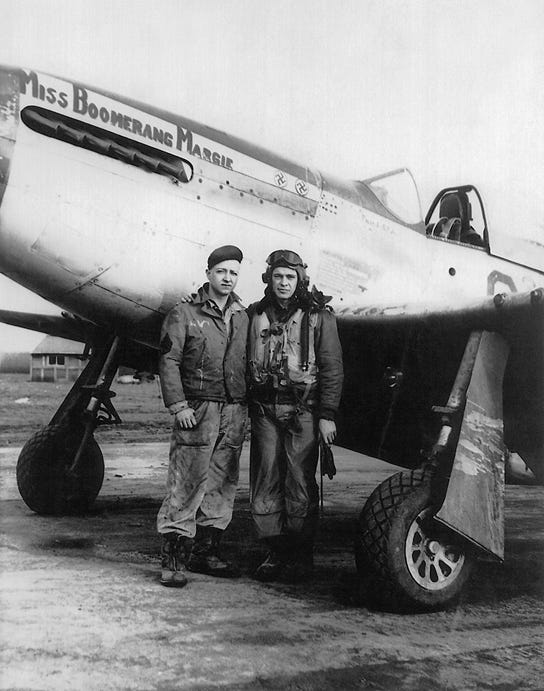Mustangs in Lubartow
Poland was a scene of the American shuttle missions, during which the USAAF attacked targets deep in Nazi Germany and then landed in the airbases in Soviet Ukraine.
For many years after the end of the WW2 hostilities it was natural to think that the air war over Poland had raged in the September 1939 campaign and later, during the Red Army offensive towards Berlin. Still, many people were (and are) passionate about the fight between the British RAF, American USAAF and Nazi Luftwaffe on the western front.
To see a P-51 "Mustang", or a P-38 "Lightning", or a B-17 "Flying Fortress" or a B-24 "Liberator" is such a beautiful and exciting experience... What a pity they had all flown so far away from here, one could say.

But things are not necessarily this way. In surprisingly many places in Poland stories are told of large four-engine silver machines or mysterious metal pieces are stored at many farms. No, no, these are not the ultimate proof for the existence of the Aliens or a trace of Hitler's last secret weapon... These bits and pieces of history confirm that the Polish skies saw the activities (and losses) of the American air forces in WW2.
Very few people know that the USAAF had heavily bombed the synthetic fuel factories in Silesia and near Szczecin (then German Stettin). Also the aircraft factories in Żary (then Sorau), Poznan (then Posen) and Malbork (then Marienburg) drew attention (and bombs) of the US bomber forces. All these places are today in Poland.

Poland was also a scene of the American shuttle missions, during which the USAAF attacked targets deep in Nazi Germany and then landed in the airbases in Soviet Ukraine. One of such missions took place on August 6th 1944. Aircraft factories in Rumia and Gdynia, both in occupied Poland, were targeted. Seventy-five B-17s from the 95th and 390th Bomb Groups participated. They were escorted by three Fighter Groups of P-51 "Mustangs". Two Fighter Groups (55th and 339th) accompanied bombers from Cuxhaven, Germany, on the North Sea to the target area. It was the longest escort mission for both units to date: 1592 miles and 6 hours 35 minutes. The last, 357th Fighter Group, took off from Great Britain at 9:30am and met the B-17s at 12:50pm near Leba, Germany, on the Baltic Sea. This Group was engaged in combat with Luftwaffe aircraft in the target area over the Bay of Gdansk, and later north of Brzesc, Poland, near the front lines. Two enemy machines were destroyed without any own losses. The escort mission was over at 4:30pm 10 miles east of Kijew, Ukraine. At 5:00pm all aircraft landed safely.

Robert M. Littlefield, a veteran of the 55th Fighter Group who shared the above photo, took part in this shuttle mission to Gdynia. He remembers sitting in a "Mustang" cockpit for seven hours as a tough challenge even for a then 22-year-old like him. From the other airmen in the photo, Robert Rosenburgh, Arthur Thorsen, Robert Callaghan and David Jewell flew the mission to Gdynia as well.
David Jewell did not make it back to England with the rest of his friends that day. Himself and his leading pilot, they had to land behind Russian lines and ended up in Lubartow, Poland (north of Lublin, Poland). Jewell still remembers this unexpected experience: "Soon after the bombers dropped their bombs, my leading pilot, Lt. Sherman, experienced engine trouble. We had been told during the mission briefing, that the 8th Air Force had an emergency airbase near Kijev, Ukraine. If a pilot thought he would not make it back to England, he should radio this airbase for the heading. We tried it a few times but without any success. We continued to fly south-east and soon saw Warsaw. The city was burning and the smoke was visible from many miles away (The Warsaw Rising started on August 1st - author's note). Not long after passing Warsaw a few Russian fighter aircraft appeared. They flew close to us and the pilots signalled with their hands that we had to land. We followed them to a small airfield located near a small town of Lubartow, Poland. The Russians used the base to provide ground support to their troops fighting nearby. Each Soviet machine took off a few times a day. Some of them were the famous Yak aircraft.”

“Nobody at this airfield spoke English and we did not know any Russian or Polish - so communication was very difficult. We were treated well. The Russians did not have much food and ate what they recquisitioned from the Polish people. But they had plenty of vodka which they generously shared with Sherman and myself.”
“We were at Lubartow for a week and finally our airbase near Kiev got the news we were over here and needed help. An aircraft with the engineers arrived and they fixed Sherman's plane. Then we flew on to our airbase in Piryatin, which was 50 miles east of Kijev. When we were in Poland, the Russians assigned an officer to us to watch over us. He was very kind to us and we respected one another. When we were about to leave, he has given a photo of himself to me and I gave him my wrist watch.”
Lt. Sherman's "Mustang" was not in a good enough condition to fly back to England. So Sherman flew back to the home airbase aboard a bomber that had been repaired in Piryatin. Jewell did not like the idea of flying alone back to England, over Germany and the North Sea. He decided to fly via Yugoslavia and Italy. He refueled in Italy and flew over France back to England. He came back to the home airbase on August 26th 1944.
Strangely enough, many many years after I had published the above story in a Polish aviation magazine, I got a message on LinkedIn. This person had read my article, did some research, and shared with me an aerial photo of the airfield at Lubartow. The photo was of very high quality, taken by German Luftwaffe on…. August 9th (sic!), 3 days after the P-51s had arrived. You will see aircraft parked around the airfield. Can you see the two Mustangs? :)




